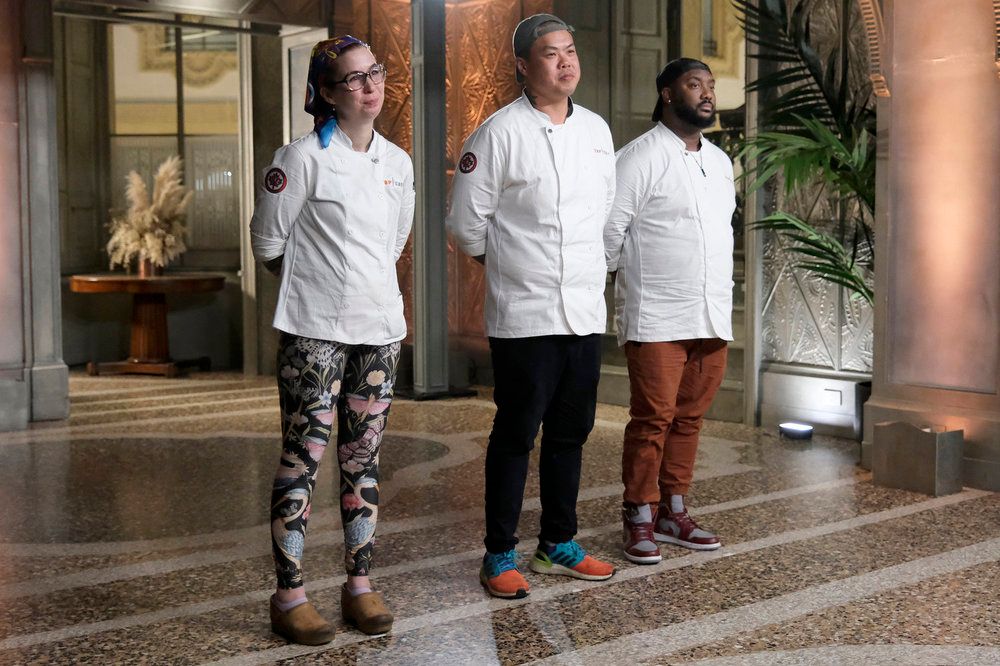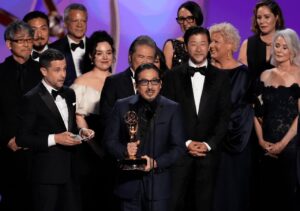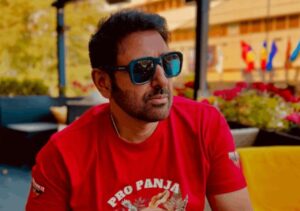
Time to give some credit to the Top Chef producers and editors where it’s due: Opening the Top Chef finale in Milan by making each chef relate their journeys to Leonardo da Vinci’s The Last Supper could have been unspeakably silly, or at least one hell of a stretch. But as Bailey, Shuai, and Tristen gaze up at the iconic mural and explain their reactions, they all make way more sense than I would’ve anticipated.
Given the rare opportunity to view The Last Supper privately, our finalists wax poetic about what being on Top Chef has meant to them. Bailey, who fought her way back into the competition from Last Chance Kitchen and has been happily experimenting with her cooking ever since, feels like she’s found her own voice. “Da Vinci painted this scene that’s been depicted a million different ways, and I feel a little bit that way about my own food,” she says. Whatever you want to say about her run — and too many bitter fans have, in a way that’s completely unhelpful and divorced from who Bailey herself is as a person — it’s great to see a chef come into her own.
Shuai, for his part, was surprised by how much fun he ended up having on the show, which he had only joined as a last-ditch effort to make a dent in the debt he and his wife had taken on to fund their projects over the years. When asked to connect his story to da Vinci’s, Shuai homes in on the idea of leaving a legacy behind. With no kids of his own, he says, food is the way he can pass on himself, his family, and their culture to the world. “Top Chef is my legacy,” he says, almost bashfully. He’s had his ups and downs in this competition, but this is such a touching moment in a way I absolutely wasn’t expecting, which is exactly how I like it.
And then there’s Tristen, the only chef maybe in Top Chef history whose reaction to Italy isn’t outward adulation. So, yeah, he has a different take. “Both physically and ideologically, this is a lot bigger than I thought it was,” he muses. He then points out that it seems like the only darker-skinned person on the fresco is Judas, which obviously hits him where it hurts — and also motivates him more than ever. “My mission has been to increase the value of Black food across the world,” Tristen says. “I’m ready to get this done.”
The chefs then go to meet Tom, Kristen, and their sous-chefs. In a slight twist on the usual, the chefs not only get to choose their own sous-chefs, but only those sous-chefs have been flown to Italy for the occasion. This frankly makes more economic sense than previous seasons’ habit of inviting everyone to destination finales, but I’m still sad not to see more of this strong cast before the end.
The most “duh” choice is from Bailey, who goes for her girl Lana. Shuai’s somewhat surprising choice is Paula. When he reminds us of Paula’s (perhaps too) selfless performance in Restaurant Wars, though, it makes a lot more sense to tap her in this supporting role. Tristen goes for Zubair — like many this season, gone too soon! — both because they vibed early on and because he thinks Zubair won’t shy away from his purposefully aggressive spice profile. Like many of my favorite Tristen moments, this reasoning is both a little shady and ultimately correct.
The brief: 2,000 euro to shop at “a variety of local shops” and five hours of prep and cook time before an additional two hours on the day of service. After the last challenge — which saw them frantically prep three dishes that may or may not get served in way less time — this feels incredibly luxurious. To be clear, that’s not a complaint! The finale dishes should represent the chefs at their absolute best. There’s no point in limiting their time for the sake of it. Also, we rarely get to see dishes that really benefit from lengthy prep work (e.g., braises, stocks, 24-hour marinades, etc.), so I’m glad the chefs got the opportunity to flex even more of their culinary muscles.
Also, watching the chefs get to shop alongside other chefs who know what they’re talking about only further confirms my annoyance with last episode’s Olympic athlete shop. Shuai and Tristen even shift their plans slightly once they see the fresh ingredients on display, particularly at the fish market. Shuai grabs a handful of prawns for his pani puri, while Tristen takes a gorgeous slab of monkfish alongside the cod he’d been looking for originally.
After prep, it’s time for my favorite newer Top Chef tradition: a pre-finale meal for the finalists cooked by the Top Chef judges themselves. It’s homey and heartfelt and, quite frankly, an incredible show of respect from these experts for what the finalists have accomplished thus far. Tom, Gail, and Kristen have gushed so much during their promotional appearances about the season’s high quality, and this meal’s no exception. Kristen’s worked in starry restaurants and traveled the world; Tom and Gail have been with Top Chef since the beginning. Whatever you thought of season 22’s challenges or edit as a whole, I’m inclined to believe these judges when they say the food they tasted this season was especially remarkable.
The chefs serve their four-course progressive meals at Cracco for guests Carlo Cracco, Sarah Cicolini of Rome’s SantoPalato, Top Chef alums Richard Blais and Gregory Gourdet, Food & Wine EIC Hunter Lewis, Santiago Lastra of Kol, and Genie Kwon and Tim Flores of Kasama. Finally, there’s English powerhouse chef Clare Smyth, who will, in fact, be their guest judge. Whew. Got all that? (Top Chef, I am begging you: Please let Kristen introduce each guest judge out loud next season! They deserve the moment, and these speedy captions are no one’s friend!!)
Each meal really does a great job of summing each chef up, both in terms of their food and their time on this show. Shuai’s is an “explosion of flavor,” Bailey once again makes unusual combos work, and Tristen’s confidence in his instincts shines right through. Tom’s so excited by the first course that he goes into the kitchen to tell them they’re crushing it. The chefs probably couldn’t absorb the enormity of that compliment while they were neck-deep in the shit, but Lana manages to realize that “Daddy said it’s good” through a shit-eating grin.
Bailey presents a menu that, she hopes, is “super whimsical and creative” à la “giro stravagante” (Italian for “eccentric turn,” per the captions). Each dish also pays homage to the chefs and cuisines that have shaped her cooking. Her first dish of octopus with mozzarella in a tomato dashi pulls from her first job in a Japanese restaurant; her second of anolini alpini with porcini pasta and pecans is inspired by her recent Calgary foraging; her third, a blackened redfish, is a tribute to her current boss and mentor (and controversial Top Chef: Texas alum), Sarah Grueneberg. Finally, she serves a tiramisu-inspired dessert of a squash torta with pizzelle cookies. The judges overall respect her willingness to flout conventional rules in otherwise conventional dishes, most especially with her pairing of seafood with cheese in course No. 1.
Shuai leans into fun by serving up what he calls “trashy fancy” takes on “Chinese mish-mosh” cuisine. He wants to show off his influences, but also just some of his favorite things, period. This results in an offbeat menu incorporating everything from Indian pani puri to pork and king-crab soup dumplings to a sweet and sour tangcu take on ossobuco with cheesy grits. He caps it all off with perhaps his boldest choice to date: a fairly straightforward ambrosia salad, that much maligned midwestern dessert that at its worst might be one of the worst things anyone’s ever eaten in their entire lives. Luckily, Shuai nails it to the point that Clare admits that since it’s the first ambrosia she’s ever had, it now probably has to be the last.
Tristen, a man perpetually on a mission, tees up a menu that takes aspects of another culture’s cuisine (this time Italian), blends it into his own (i.e., Afro-Caribbean), and creates something entirely new. First up is a fish and baccalà mbongo to blend European and African flavors together. Second, he makes injera toast alongside a mashup of two chicken dishes — Ethiopian doro wat and Italian marengo — to make a “dorengo” that practically sends Tom into raptures. Next is a Trinidadian oxtail “Milanese” with rice grits; finally, a root-vegetable cake and cassareep ice cream.
As Tristen explains during prep, he’s “essentially trying to uncolonize colonized dishes.” Later, when introducing his menu to the all-star slate of guest judges, he underlines the point even further. “I always kind of looked at my own cuisine as something that wasn’t really revered and valued at tables like this,” he says, unafraid to address the fine-dining setting with just the right amount of disdain.
Everyone at the table seems into Tristen’s meal; Carlo Cracco’s especially moved to the point that he has “no words, [because] it’s perfect.” But I’m so glad Gregory Gourdet, in particular, was there to point out the nuances and meaning of what Tristen’s doing. His Portland restaurant, Kann, celebrates Haitian cuisine (gorgeously, might I add, having been lucky enough to eat there only a couple of weeks ago); his new place in a luxury French department store specifically serves food inspired by former French colonies. Gregory sees himself on Tristen’s plate and is moved by it. “Tristen and I are wanting to elevate certain cultures of food in a fine-dining space,” he explains. “He did great. I get it all.”
Compared to other finales we’ve seen, the “weak” spots of the three meals are relatively inoffensive. Shuai’s soup dumpling is dry, and his grits too cheesy. Bailey’s fish course is a little overcooked and feels more like her mentor’s than her own. Tristen’s dessert is more respected around the table than outright liked. In a finale this strong, though, these are the nitpicks that can be the difference between being a finalist and a winner — but it’s obvious that Shuai and Bailey’s criticisms are still more substantial than anything anyone has to say about Tristen.
So even though it’s a strong showing for all three of them, it shouldn’t surprise anyone who watched this season which chef stood above the others in terms of flavors, consistency, creativity, and overall ambition. “Someone delivered very distinct flavors, with a distinct point of view, that I can’t get out of my head,” as Tom puts it before the reveal. “A tough decision,” Kristen says — and for the first time this season, I don’t believe her.
Because of course it’s Tristen. Who else could it be? He always knew what he wanted to do and did it in a way only he can, to unexpected and completely delicious results. That’s a Top Chef right there, baby. Good for him! Great for food! What more could we ask for from a winner than that?
Leftovers
• I deeply appreciate Tristen’s commitment to highlighting underappreciated food, doing right by his family, and honoring those who came before him. But I hope the enormous vote of confidence that is winning Top Chef gives him the opportunity to enjoy the moment for himself, too. He earned it.
• In fact, Tristen crushed his meal so thoroughly that when Richard Blais came in hot with, “It’s too spicy! I don’t want effervescent ice cream!” (that makes one of us), no one bothered to entertain it. As Cracco said, tipping an imaginary hat practically through tears: “This is a chef.”
• “It’s just like Restaurant Wars! I’m cleaning seafood, you’re doing … everything else …”
• “I broke the cutting board!” “Okay, calm down, Massimo.”
• Another season of Top Chef down! Thank you all for reading these recaps and having such great conversations in the comments along the way. I love this show and hope I get to watch and think way too hard about it for years to come.
All three finalists have strong showings, but it’s clear which chef stands above the others in terms of flavors, creativity, and overall ambition.

































































